Lion House Dinner Rolls
These dreamy lion house dinner rolls are tender, buttery, perfect, and almost indulgent enough for dessert!
There isn’t much more I can say about these rolls than they make an appearance at my dinner table several times a month and are probably only one of two or three roll recipes I make regularly.
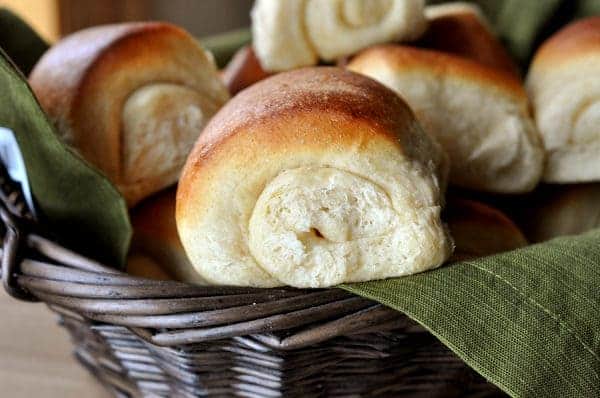
I usually substitute half the white flour with white wheat flour, but when made with 100% white flour, they are almost indulgent enough to eat for dessert.
Tender, buttery, perfect.
I love them and it would have to take a mighty good roll recipe to replace these beauties.
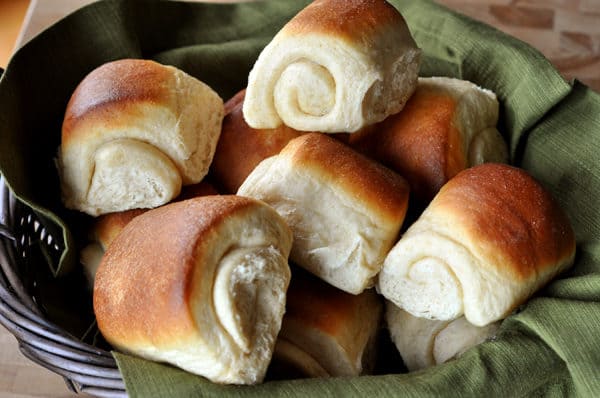
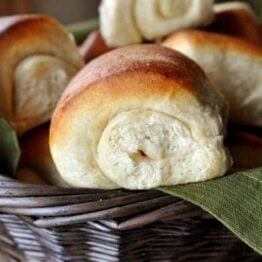
Lion House Dinner Rolls
Ingredients
- 2 tablespoons active dry yeast
- 2 cups warm water
- ⅓ cup (71 g) sugar
- ⅓ cup (75 g) butter, softened
- 1 large egg
- 2 ½ teaspoons salt
- ⅔ cup nonfat dry milk
- 5-6 cups (710 to 852 g) flour (see note)
Instructions
- In a large bowl, combine the yeast and water. Let stand 5 minutes (no need to do this if using instant yeast – just add the yeast and water together with the other ingredients). Add sugar, butter, salt, dry milk, 2 cups flour and egg. Beat together until very smooth. Add remaining flour gradually (about 1/2 cup at a time) until a soft but not sticky dough is formed. Knead the dough for at least five minutes if using an electric mixer and for at least 10 minutes if mixing the dough by hand. When the dough is smooth, supple and elastic, place it in a lightly greased large bowl covered with greased plastic wrap and let it rise until doubled.
- Separate the dough into two portions. Roll each section out to an 11X14-inch rectangle. Brush the top with melted butter. Using a pizza cutter or sharp knife, cut the dough into two pieces, the long way (see photos below). Then slice the dough into five or six strips across so you end up with 10 to 12 small rectangles. Roll each small rectangle up like a snail and place on a silpat-lined or lightly greased baking sheet with the roll resting on it’s open edge. Repeat with the second portion of dough.
- Cover the rolls with lightly greased plastic wrap and let them rise until doubled. Bake at 375 degrees for 12-14 minutes until they are nicely browned.
Notes
Recommended Products
Recipe Source: from The Lion House
Roll out the dough to about an 11X14-inch rectangle.
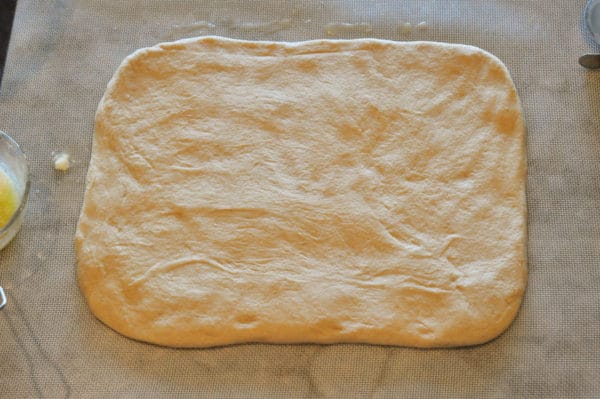
Brush with melted butter then slice the dough in half the long way.
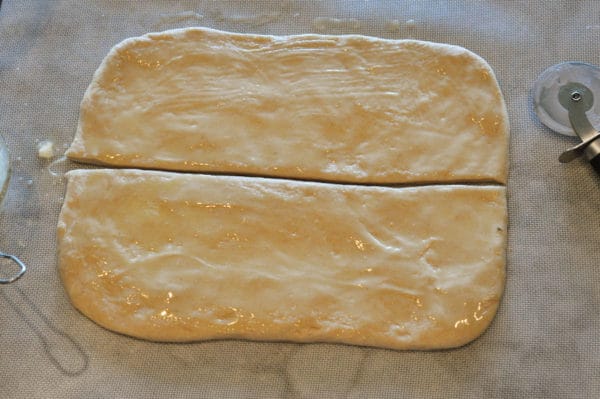
Use your hand measure in an “L” shape to measure the approximate distance to slice each rectangle for the individual rolls.
Continue with that method until the rectangle is sliced into five or six sections across, giving you 10 to 12 rectangles total.
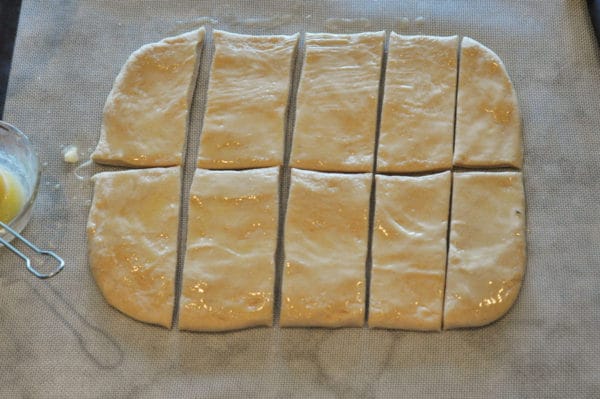
Roll each rectangle up like a snail.
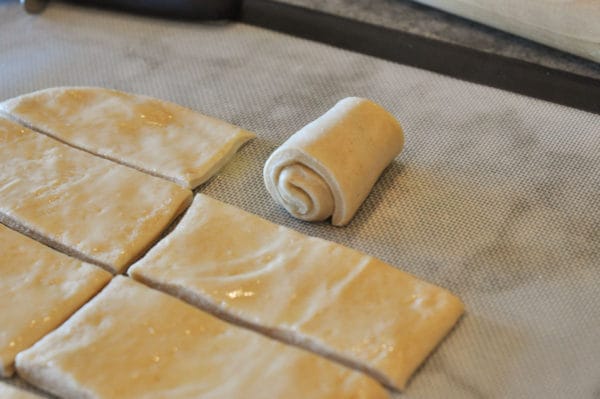
Place on the sheet pan with the roll resting on the open edge.
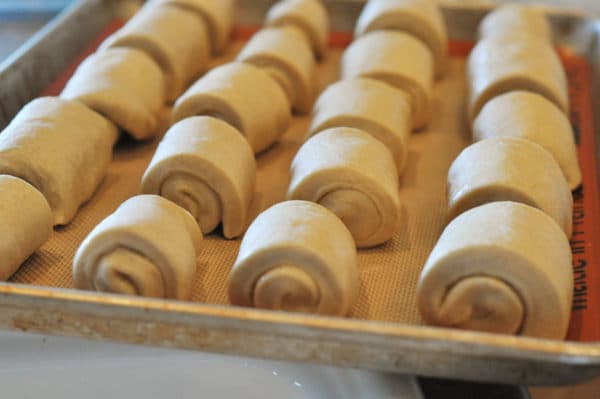

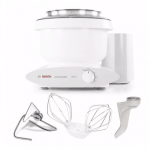
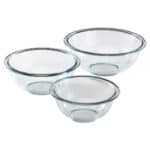
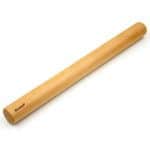
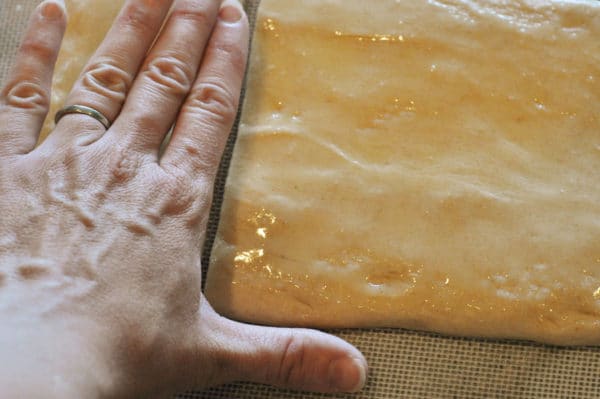
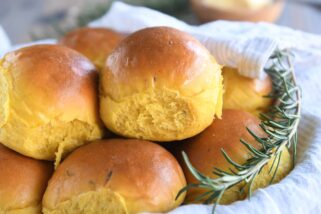
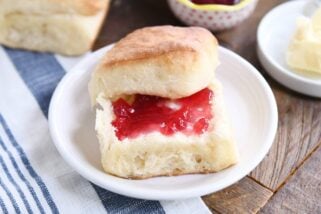
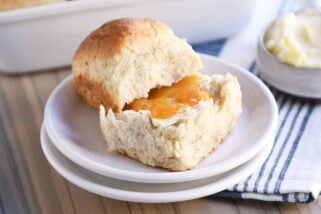
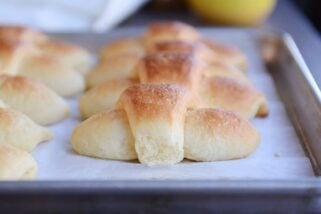
These are the best rolls! They are everyone’s favorite at Thanksgiving and make the best sandwiches for leftovers. Make extra! They freeze really well.
This is my go-to recipe for family gatherings. It is always a crowd favorite! They also freeze well if you want to make ahead.
Can I make the dough the night before and put the uncooked rolls in the fridge over night or will that not work?
Yes, that should work just fine.
If I double this recipe do I also double the yeast?
Thanks!
Yes!
Just thought I’d point out to other recipe hunters, that although this was posted years ago, it continues to be one of the best recipe for rolls in the world. Lion House rolls are sooooo good, and this recipe is spot on.
This works wonderfully for baked samosas. Do you have any recommendations for making the dough a day ahead? Will it keep in the fridge for baking the next day?
Yes, it should work just fine refrigerated for a day.
Thank you for sharing this recipe! This has become a family dinner must! I usually make 80-100 rolls every holidays.
Hi Mel! I would like to trial run these before Thanksgiving, do you think I can half this recipe? The only thing I struggle with is the one egg?
Yes, for sure! Use just an egg yolk for a half recipe.
Do you think this recipe could be made into hamburger buns or hot dog rolls? My family just love this recipe when I made it.
I bet it could!
I loved them and they were easy to do with your instructions!
Easy to work with, turned out great! I couldn’t find the link to the tutorial that you mentioned in the notes so I just googled it and found a video for how to roll the rolls, so fun!
Hi Mel. I really hope that you get this message. This is S, from Tuscumbia, Alabama! I just wanted to let you know that I love your blog, and have used sooo many of your recipes. This love started with the hot fudge pudding cake, proceeded into the brookie pie, was accelerated by the meatloaf, improved with the cinnamon roll cake, was enhanced by the parker house rolls, was benefited by the honey oat rolls, and now, this love has been fulfilled with the lion house rolls. ☺☺☺
If you were to ask me what is the one thing that differentiates your recipes from others, I would not really know! I, however, believe that the success of your recipes stems from the great love and desire you have to help others feed their families, not from the hope for monetary gain or fame. It is as if you were inviting everyone to your home kitchen and were sharing your love of generous cooking/baking. Please do continue to share your kindness and encouragement via your recipes, and know that, a nineteen year old girl is enthusiastically trying to perfect her cooking skills in an Alabama kitchen, as if she were right by your side in your own home kitchen in Idaho…..God bless you, and may He reward you richly, both in this life, and in the next one. ♥♥♥♥♥
This was just the best thing I could have read today. Thank you! Thank you so much. I smiled through the whole first paragraph – your entire comment warmed my soul in a way it needed to be warmed today. Thank you!
Love, love, love these rolls! Our holiday go-to, now!
These turned out beautifully! I used 1/2 whole wheat flour and 1/2 AP along with dry buttermilk powder rather than the nonfat just because it is what I had on hand. Even with the extra time/effort to knead by band, it was totally worth the wait. I am excited to have our freezer restocked with some wholesome bread.
I made these rolls for a friend dinner and they were so good, we made up a song about them! And while they are great as lion house rolls, this recipe has also become my go to recipe for a simple loaf of bread as well as for cinnamon rolls. My coworker said today that they’re the best cinnamon rolls he’s ever had. 10 0ut of 10 would recommend!
Haha, would love to hear that song!!
These are the best rolls I have ever made! I’ve made them a few times now and each time I do I am blown away at how yummy they are and how pretty they turn out. My family all ask for the recipe and I tell them to come here! Your the best Mel!
Easy to put together. Looked beautiful. Smelled amazing. Taste was ok, was expecting to be wowed but wasn’t.
These turned out well. Everyone enjoyed them.